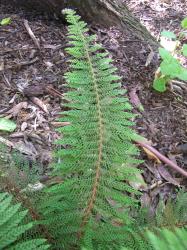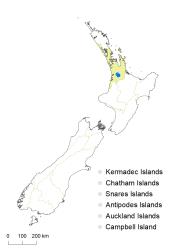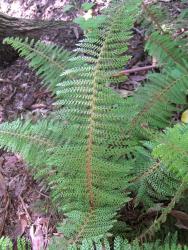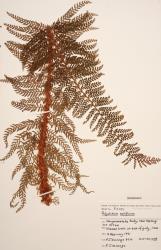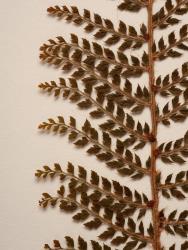- ≡ Polypodium setiferum Forssk., Fl. Aegypt.-Arab. 185 (1775)
Rhizomes erect, densely scaly. Rhizome scales ovate, 15–16 mm long, 4.5–7 mm wide, uniformly pale orange-brown, margins entire. Fronds 450–600 mm long, often prostrate. Stipes 25–120 mm long, pale or yellow-brown, densely scaly throughout; scales ovate or narrowly ovate, uniformly pale orange-brown, apices acuminate, margins ciliate or toothed. Rachises pale or yellow-brown, sulcate, not winged, often bearing bulbils at junctions with the primary pinnae, densely scaly; scales on both surfaces narrowly ovate to ± linear, pale orange-brown. Laminae 3-pinnate at base, narrowly ovate or narrowly triangular, 420–600 mm long, 90–200 mm wide, pale green on both surfaces, coriaceous, bearing abundant pale brown scales on abaxial costae and lamina surfaces, ± glabrous on adaxial surfaces. Primary pinnae in 40–60 pairs below pinnatifid apex, slightly overlapping, narrowly ovate or narrowly oblong; the longest at or near the base, 60–110 mm long, 15–25 mm wide, apices acuminate, bases stalked; costae not winged, or winged only near the pinna apex. Secondary pinnae decreasing in length only near the apices of the primary pinnae; the longest oblong or ovate, 10–18 mm long, 2–6 mm wide, apices drawn into long sharp points, margins sharply and deeply serrate, or divided into tertiary pinnae, bases stalked. Tertiary pinnae ovate, up to 4 mm long, and 2 mm wide. Sori round, medial or nearer margin than costa; indusia round, 1–1.2 mm diameter, ± concolorous, lacking a dark central area.
Polystichum setiferum is readily distinguished by its prostrate fronds with narrowly ovate or narrowly triangular laminae, and the presence of bulbils at the junctions of the primary pinnae and rachis. No other species of Polystichum in New Zealand produces bulbils in this way.
North Island: Auckland.
Altitudinal range: 20–40 m.
A cultivar of the common European species, Polystichum setiferum, is widely grown in gardens and has been recorded as a garden escape in a few places around Hamilton.
Polystichum setiferum occurs as an escape on clay or sandy banks and waste land, often under willows, acacias or light shade, or among blackberry and bracken.
Brownsey (1981). Voucher WELT P010261, 1979.
The naturalised plants in New Zealand are all the cultivar ‘Divisilobum Pulcherrimum’ of the European species.



